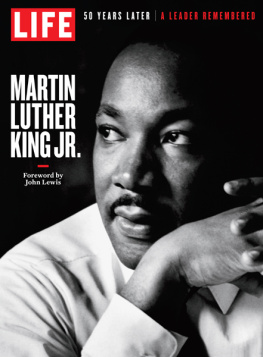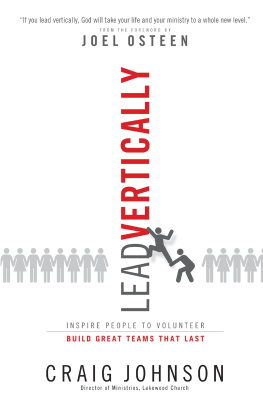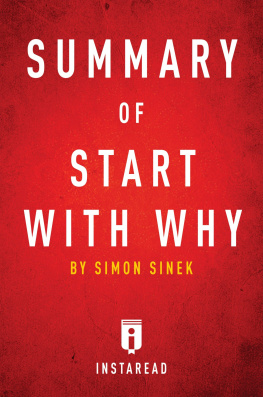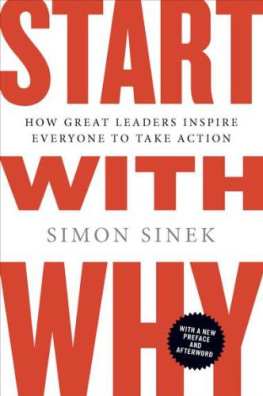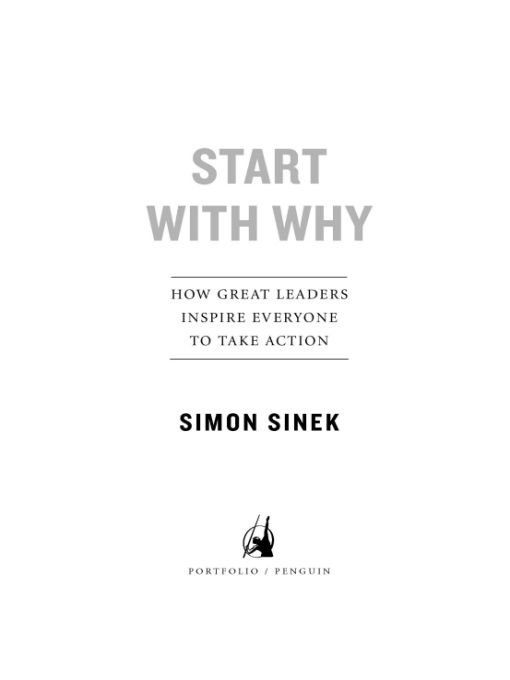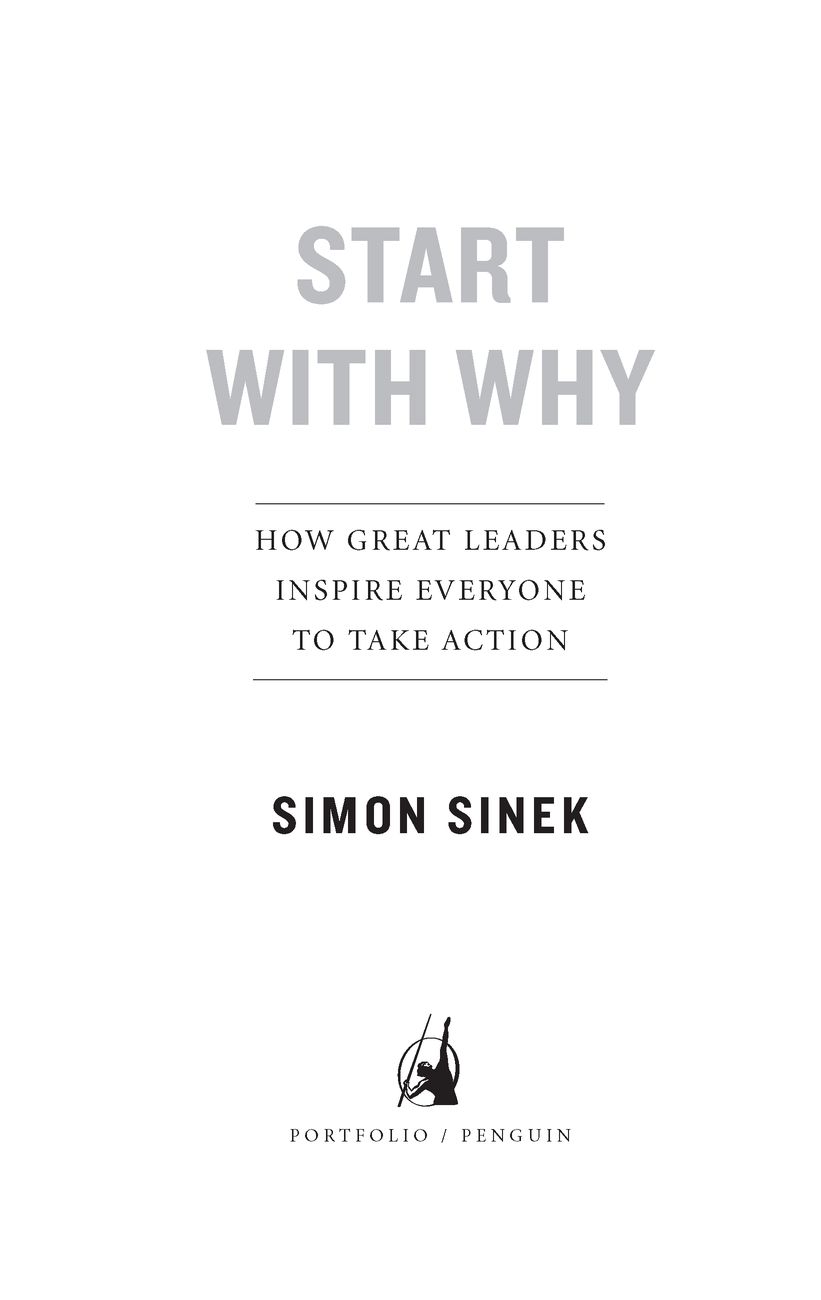Table of Contents
PORTFOLIO / PENGUIN
START WITH WHY
Simon Sinek is leading a movement to inspire people to do what inspires them.
With a bold goal to build a world in which the vast majority of people go home every day feeling fulfilled by their work, he is invited to share the concept of WHY with a dizzying array of organizations. From members of Congress to foreign ambassadors, from small businesses to corporations Microsoft and Wal-Mart, from Hollywood to NASA to the Pentagon, those who want to inspire people want to learn about the WHY. His TEDx Talk about WHY is one of the top twenty most viewed talks on TED.com.
Sinek is also an adjunct staff member of the RAND Corporation, teaches graduate level strategic communications at Columbia University, and is active in the arts and not-for-profit world. When not living in hotels, he lives in New York City.
For Victoria,
who finds good ideas
and makes them great
There are leaders and there are those who lead.
Leaders hold a position of power or influence.
Those who lead inspire us.
Whether individuals or organizations, we follow those
who lead not because we have to, but because we want to.
We follow those who lead not for them, but for ourselves.
This is a book for those who want to inspire others and
for those who want to find someone to inspire them.
PREFACE
THE POWER OF WHY
When I first discovered this thing called the WHY, it came at a time in my life when I needed it. It wasnt an academic or intellectual pursuit; I had fallen out of love with my work and found myself in a very dark place. There was nothing wrong with the quality of my work or my job, per se; it was the enjoyment I had for that work that Id lost. By all superficial measurements, I should have been happy. I made a good living. I worked with great clients. The problem was, I didnt feel it. I was no longer fulfilled by my work and I needed to find a way to rekindle my passion.
The discovery of WHY completely changed my view of the world and discovering my own WHY restored my passion to a degree multiple times greater than at any other time in my life. It was such a simple, powerful, and actionable idea, that I shared it with my friends. Thats what we do when we find something of value, we share it with the people we love. Inspired, my friends started making big life changes. In turn, they invited me to share this idea with their friends, the people they loved. And so the idea started to spread.
It was at this point I decided to turn myself into the guinea pig. It didnt seem right that I would share or promote a concept that I didnt practice myself. So I was going to practice it as wholly as I could. The only reason I am where I am today, this representative of WHY, is for one reason and one reason only: because of other people.
I have no publicist. I have had only very little national press coverage. Yet the concept of WHY is spreading far and wide because it resonates with people on such a visceral level that they share it with those they love and care about. That I was given the opportunity to write a book about the concept has allowed the depth idea to spread without me. The TEDx Talk I gave that was posted on ted.com continues to spread far and wide not because of any social media strategy. It spreads because this message is inherently optimistic. It is inherently human. And those who believe in it share it.
The more organizations and people who learn to also start with WHY, the more people there will be who wake up feeling fulfilled by the work they do. And thats about the best reason I can think of to continue sharing this idea.
Inspire on!
Simon Sinek
New York
July 28, 2011
INTRODUCTION
WHY START WITH WHY?
This book is about a naturally occurring pattern, a way of thinking, acting and communicating that gives some leaders the ability to inspire those around them. Although these natural-born leaders may have come into the world with a predisposition to inspire, the ability is not reserved for them exclusively. We can all learn this pattern. With a little discipline, any leader or organization can inspire others, both inside and outside their organization, to help advance their ideas and their vision. We can all learn to lead.
The goal of this book is not simply to try to fix the things that arent working. Rather, I wrote this book as a guide to focus on and amplify the things that do work. I do not aim to upset the solutions offered by others. Most of the answers we get, when based on sound evidence, are perfectly valid. However, if were starting with the wrong questions, if we dont understand the cause, then even the right answers will always steer us wrong... eventually. The truth, you see, is always revealed... eventually.
The stories that follow are of those individuals and organizations that naturally embody this pattern. They are the ones that start with Why.
1.
The goal was ambitious. Public interest was high. Experts were eager to contribute. Money was readily available.
Armed with every ingredient for success, Samuel Pierpont Langley set out in the early 1900s to be the first man to pilot an airplane. Highly regarded, he was a senior officer at the Smithsonian Institution, a mathematics professor who had also worked at Harvard. His friends included some of the most powerful men in government and business, including Andrew Carnegie and Alexander Graham Bell. Langley was given a $50,000 grant from the War Department to fund his project, a tremendous amount of money for the time. He pulled together the best minds of the day, a veritable dream team of talent and know-how. Langley and his team used the finest materials, and the press followed him everywhere. People all over the country were riveted to the story, waiting to read that he had achieved his goal. With the team he had gathered and ample resources, his success was guaranteed.
Or was it?
A few hundred miles away, Wilbur and Orville Wright were working on their own flying machine. Their passion to fly was so intense that it inspired the enthusiasm and commitment of a dedicated group in their hometown of Dayton, Ohio. There was no funding for their venture. No government grants. No high-level connections. Not a single person on the team had an advanced degree or even a college education, not even Wilbur or Orville. But the team banded together in a humble bicycle shop and made their vision real. On December 17, 1903, a small group witnessed a man take flight for the first time in history.
How did the Wright brothers succeed where a better-equipped, better-funded and better-educated team could not?
It wasnt luck. Both the Wright brothers and Langley were highly motivated. Both had a strong work ethic. Both had keen scientific minds. They were pursuing exactly the same goal, but only the Wright brothers were able to inspire those around them and truly lead their team to develop a technology that would change the world. Only the Wright brothers started with Why.
2.
In 1965, students on the campus of the University of California, Berkeley, were the first to publicly burn their draft cards to protest Americas involvement in the Vietnam War. Northern California was a hotbed of antigovernment and antiestablishment sentiment; footage of clashes and riots in Berkeley and Oakland was beamed around the globe, fueling sympathetic movements across the United States and Europe. But it wasnt until 1976, nearly three years after the end of Americas military involvement in the Vietnam conflict, that a different revolution ignited.




